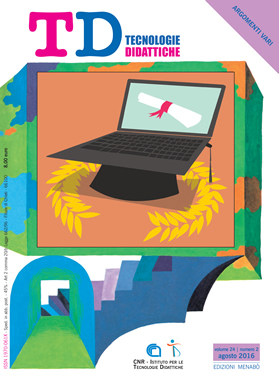Physics lab activities with Inquiry Learning Spaces
Main Article Content
Abstract
A middle school physics experience using smartphones.
Article Details
Authors who publish with this journal agree to the following terms:
- Authors retain copyright and grant the journal right of first publication with the work simultaneously licensed under a Creative Commons CC BY 4.0 Attribution 4.0 International License.
- Authors are able to enter into separate, additional contractual arrangements for the non-exclusive distribution of the journal's published version of the work (e.g., post it to an institutional repository or publish it in a book), with an acknowledgement of its initial publication in this journal.
- Authors are permitted and encouraged to post their work online (e.g., in institutional repositories or on their website) prior to and during the submission process, as it can lead to productive exchanges, as well as earlier and greater citation of published work (See The Effect of Open Access)
References
Borasi, R., & Fonzi. J. (2002). In Foundation: A monograph for professionals in science, mathematics, and technology education. Arlington, VA: National Science Foundation. Retrieved from http://www.nsf.gov/pubs/2000/ nsf99148/start.htm
De Jong, T. (2014). Preliminary inquiry classroom scenarios and guidelines. http:// www.go-lab-project.eu/sites/default/files/files/ deliverable/file/Go-Lab_D3.1.pdf
Landriscia, F. (2009). La simulazione nell’apprendimento. Quando e come avvalersene. Trento, Italia: Erickson.
Maglioni, M., Biscaro, F. (2014). La classe capovolta. Innovare la didattica con il flipped classroom. Trento, Italia: Erickson.
MIUR. Ministero dell’Istruzione, dell’Università e della Ricerca (2012). Indicazioni Nazionali per il curricolo della scuola dell’infanzia e del primo ciclo. Retrieved from http://www. indicazioninazionali.it/documenti_Indicazioni_ nazionali/Indicazioni_Annali_Definitivo.pdf
MIUR. Ministero dell’Istruzione, dell’Università e della Ricerca (2015). Piano Nazionale Scuola Digitale. Retrieved from http://www.istruzione. it/scuola_digitale/index.shtml.
Ranieri, M. (2015). Bring Your Own Device all’Università. Un’esperieza di storytelling con i dispositive mobile. TD Tecnologie Didattiche, 23(1), 46-49. doi:10.17471/2499-4324/267
Ranieri, M., & Bruni, I. (2013). Racconto e mi racconto con il cellulare. In A. Parola, A. Rosa, & R. Giannatelli (Eds.), Media, linguaggi, creatività. Trento, Italia: Erickson.
Ranieri, M., & Pieri, M. (2014). Mobile learning. Dimensioni teoriche, modelli didattici, scenari applicativi. Milano, Italia: Unicopli.
Rodriguez-Triana, M., Govaerts, S., Halimi, W., Holzer, A., Salzmann, V., De Jong, T., … Gillet, D. (2014). Rich open educational resources for personal and inquiry learning: Agile creation, sharing and reuse in educational social media platforms. Proceedings Web and Open Access to Learning (ICWOAL), 2014 International Conference on IEEE. Retrieved from http://goo. gl/6Pnzxg (ver. 01.11.2015).
Silva, N. (2012). Magnetic field sensor. The Physics Teacher, 50(6), 372-373. doi:10.1119/1.4745697
Topping, K. J. (1996). The effectiveness of peer tutoring in further and higher education: A typology and review of the literature. Higher education, 32(3), 321-345. doi:10.1007/ BF00138870
Vogt, P., Kuhn, J., & Müller, S. (2011). Experiments using cell phones in physics classroom education: The computer-aided g determination. The Physics Teacher, 49(6), 383-384. doi:10.1119/1.3628272

